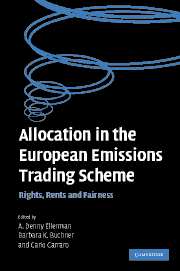Book contents
- Frontmatter
- Contents
- List of figures
- List of boxes
- List of tables
- List of contributors
- Introductory note/Foreword
- Acknowledgements
- Glossary and abbreviations
- Part I The EU ETS allocation process
- Part II Experiences from Member States in allocating allowances
- 3 United Kingdom
- 4 Germany
- 5 Denmark
- 6 Sweden
- 7 lreland
- 8 Spain
- 9 Italy
- 10 Hungary
- 11 Czech Republic
- 12 Poland
- Part III Concluding remarks and background material
- Appendix I Participants
- Appendix II The individual country outlines
- Appendix III The country tables
- Appendix IV Background material from the European Commission
- Index
9 - Italy
Published online by Cambridge University Press: 22 September 2009
- Frontmatter
- Contents
- List of figures
- List of boxes
- List of tables
- List of contributors
- Introductory note/Foreword
- Acknowledgements
- Glossary and abbreviations
- Part I The EU ETS allocation process
- Part II Experiences from Member States in allocating allowances
- 3 United Kingdom
- 4 Germany
- 5 Denmark
- 6 Sweden
- 7 lreland
- 8 Spain
- 9 Italy
- 10 Hungary
- 11 Czech Republic
- 12 Poland
- Part III Concluding remarks and background material
- Appendix I Participants
- Appendix II The individual country outlines
- Appendix III The country tables
- Appendix IV Background material from the European Commission
- Index
Summary
Introductory background and context
Throughout its development process the Italian National Allocation Plan (NAP) required by Directive 2003/87/EC (the EU ETS Directive) had to face a complex context. The challenging emission reduction commitments taken up by Italy through the Kyoto Protocol had to be pursued vis-à-vis a number of challenging issues including: rapidly rising greenhouse gas (GHG) emissions trend, contrasting energy policy objectives of supply diversification and smooth market liberalisation, challenging time-frames, lack of data and a climate of political uncertainty over the entry into force of the Kyoto Protocol itself. Furthermore, at both the EU and national level lack of clarity existed over the role of the EU ETS as a ‘policy setting’ rather than a ‘policy compliance’ tool. All of these issues have significantly influenced the NAP development process and their understanding is critical for drawing conclusions over lessons to be learnt.
Italy's reduction target and abatement potential
Italy's GHG emissions reduction target under the Burden Sharing Agreement (BSA) appears relatively modest when compared in absolute terms to targets of other Member States. However, it becomes quite challenging when considering the country's rising emission levels and high abatement costs. Under the BSA Italy has committed to a 6.5% reduction of its 1990 GHG emissions. A commitment requiring in absolute terms a reduction from the 508 Mt CO2e per year emitted in 1990 to an average 476 Mt CO2e per year during the period 2008–2012.
However, a number of factors make such an apparently limited reduction extremely challenging.
- Type
- Chapter
- Information
- Allocation in the European Emissions Trading SchemeRights, Rents and Fairness, pp. 213 - 245Publisher: Cambridge University PressPrint publication year: 2007

